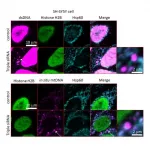(Press-News.org) Scientists say naked mole rats - a rodent native to West Africa - may hold the key to new treatments for degenerative diseases such as cancer and dementia.
The reclusive animals have a lifespan far in excess of other rodents - for example, mice and rats live about two years, whereas naked mole rats can live for 40 or 50 years.
Researchers at the University of Bradford say the animals have a unique DNA repair mechanism that enables them to prevent cancers and other degenerative conditions, including dementia.
Cancer resistant
Professor Sherif El-Khamisy, Director of the Institute of Cancer Therapeutics at the University, said: "Naked mole rats are fascinating creatures, not least because they are so long lived compared to other rodents of the same size. They also do not suffer from - what we call in humans - age associated disorders, such as cancer, dementia and neurological decline.
"What we're trying to do is to understand what makes them so resistant and then to try to harness that knowledge to come up with new treatments for cancer and conditions like dementia in people.
"This is not about extending life but extending the quality of life."
DNA mutations
Prof El-Khamisy, from the University's Faculty of Life Sciences, is the lead author of a paper, DNA Homeostasis and Senescence: Lessons from the Naked Mole Rat, recently published in the International Journal of Molecular Sciences.
It states: "As we age, our bodies accrue damage in the form of DNA mutations. These mutations lead to the generation of sub-optimal proteins, resulting in inadequate cellular homeostasis and senescence*. The build-up of senescent cells negatively affects the local cellular micro-environment and drives ageing associated disease, including neurodegeneration.
"Which processes show an increased burden as naked mole rats age may identify novel biological targets to mitigate our own degeneration."
Prof El-Khamisy added: "This is a new area of research, so there are still lots of things we don't know. For example, Alzheimer's and dementia are caused by protein aggregations in the brain and this has been a puzzle to scientists for many years. There are questions around how those proteins form and also how the body deals with them. Clearly, naked mole rats are much better than us at dealing with them.
"If we can work out how they do this, we could look to adopt similar systems in humans or to use these markers as a predictive tool to be able to say 'this person is more likely to develop dementia or cancer as they age', and then take appropriate steps."
Naked mole rats fact file
Naked mole rats are mostly hairless, wrinkly rodents that grow to between three and 13 inches.
They live for 40 or 50 years and are immune to cancer and some types of pain, such as that from biting insects and spicy plants.
In the wild, they live in hierarchical colonies (with a queen, soldiers and workers) sometimes numbering up to 300, creating a warren of underground tunnels and rooms the size of several football pitches.
They live most of their lives in caves or underground, yet despite their lack of exposure to the sun, they have a strong circadian rhythm.
A pup naked mole rat weighs less than a penny.
* In biology, homeostasis is the state of steady internal, physical, and chemical conditions maintained by living systems; whereas senescence is the condition or process of deterioration with age.
INFORMATION:
Niigata, Japan - Researchers from Brain Research Institute, Niigata University, Japan may have unraveled a new approach that could revolutionize the treatment, prevention, and possibly reversal of the damages that could lead to Parkinson's Disease (PD). This novel finding utilizing the cellular and zebrafish models, demonstrated how the leakage of mitochondrial dsDNA into the cytosol environment of the cell can contribute to the impairment of brain tissue of patients with PD.
Parkinson's disease is the second most common neurodegenerative disease, and its prevalence ...
Surgeons can ease their patients' pain from common operations without prescribing opioids, and avoid the possibility of starting someone on a path to long-term use, a pair of new studies suggests.
Treating post-surgery pain with non-opioid pain medications such as ibuprofen or acetaminophen didn't lead to higher pain levels or more serious issues during recovery, and didn't dampen patients' satisfaction with their care, according to new results from a study of more than 22,000 patients who had one of seven common operations at 70 hospitals.
The team behind the study has also produced a free, evidence-based guide for surgeons and other acute care providers, ...
People often think about human behavior in terms of what is happening in the present--reading a newspaper, driving a car, or catching a football. But other dimensions of behavior extend over weeks, months, and years.
Examples include a child learning how to read; an athlete recovering from a concussion; or a person turning 50 and wondering where all the time has gone. These are not changes that people perceive on a day-to-day basis. They just suddenly realize they're older, healed, or have a new development skill.
"The field of neuroscience looks at the brain in multiple ways," says Franco Pestilli, a neuroscientist at The University of Texas at Austin (UT Austin). "For ...
Researchers have discovered that the common bacteria E. coli can be deployed as a sustainable way to convert post-consumer plastic into vanillin, a new study reveals.
Vanillin is the primary component of extracted vanilla beans and is responsible for the characteristic taste and smell of vanilla.
The transformation could boost the circular economy, which aims to eliminate waste, keep products and materials in use and have positive impacts for synthetic biology, experts say.
The world's plastic crisis has seen an urgent need to develop new methods to recycle polyethylene terephthalate (PET) - the strong, lightweight plastic derived from non-renewable materials such as oil and gas and widely used for ...
High-speed internet access has gone from an amenity to a necessity for working and learning from home, and the COVID-19 pandemic has more clearly revealed the disadvantages for American households that lack a broadband connection.
To tackle this problem, Michigan State University researchers have developed a new tool to smooth the collection of federal broadband access data that helps pinpoint coverage gaps across the U.S. The research was published May 26 In the journal PLOS ONE.
"Nearly 21% of students in urban areas are without at-home broadband, while 25% and 37% lack at-home broadband in suburban ...
Researchers at Michigan Medicine found a subset of middle-aged men with cerebral palsy are up to 5.6 times more likely to suffer fractures than men without the disorder.
"We are not really sure why this happens," said Edward A. Hurvitz, M.D., professor and chair of the Michigan Medicine Department of Physical Therapy and Rehabilitation. "It may be related to structural differences that occur during adolescent growth, or to greater bone mineral loss at earlier age for people with cerebral palsy compared to peers."
For a study published in BONE, the team examined the timing and site of bone fractures for around ...
JUNE 10, 2021, NEW YORK - A Ludwig Cancer Research study adds to growing evidence that immune cells known as macrophages inhabiting the body cavities that house our vital organs can aid tumor growth by distracting the immune system's cancer-killing CD8+ T cells.
Reported in the current issue of Cancer Cell and led by Ludwig investigators Taha Merghoub and Jedd Wolchok at Memorial Sloan Kettering (MSK) and Charles Rudin of MSK, the study shows that cavity-resident macrophages express high levels of Tim-4, a receptor for phosphatidylserine (PS), a molecule that they surprisingly ...
Earlier this year, the US National Institutes of Health (NIH) acknowledged the impact of structural racism on biomedical science and committed to doing more to dismantle it. Now, in a commentary appearing June 10 in the journal Cell, NIH Director Francis Collins (@NIHDirector) and colleagues describe the NIH's UNITE initiative and how it differs from the agency's previous diversity, equity, and inclusion efforts.
The UNITE initiative was launched on February 26, 2021 and, for the first time, brings together all 27 NIH institutes to focus on structural racism. It is made up of five committees with members from across the agency and aims to accelerate efforts to address racism ...
A new device that fits over a person's ears and enables non-invasive measurement of real-time changes in blood alcohol levels through the skin is presented in a proof-of-principle study in Scientific Reports.
The device, devised by Kohji Mitsubayashi and colleagues, consists of a modified pair of commercial earmuffs that collect gas released through the skin of a person's ears, and an ethanol vapour sensor. If the sensor detects ethanol vapour, it releases light, the intensity of which allows for ethanol concentrations to be calculated.
The authors used their device to continuously monitor ethanol vapour released through the ears of three male volunteers, who had consumed alcohol with a concentration of 0.4 g per kg body weight, for 140 ...
A new study, published now in Nature Ecology and Evolution, draws on pollen records from tropical regions formerly claimed by the Spanish Empire in both the Atlantic and the Pacific, to test the significance and extent of forest regrowth following widespread mortality among Indigenous populations after European contact in the 15th and 16th centuries. By analyzing microscopic pollen grains preserved in lake sediments, scientists are able to build up a picture as to how environments have changed over time.
It is well documented that the arrival of Europeans in the Americas ...




